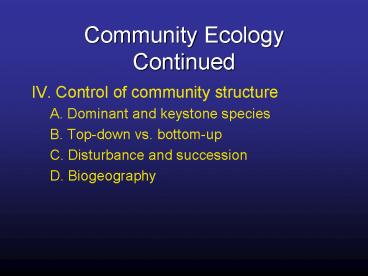Community Ecology Continued - PowerPoint PPT Presentation
1 / 26
Title:
Community Ecology Continued
Description:
highest abundance or biomass in a community ... they could also be dominant because they are most successful at avoiding predation ... Heron Island. Fig. 53.17 ... – PowerPoint PPT presentation
Number of Views:26
Avg rating:3.0/5.0
Title: Community Ecology Continued
1
Community Ecology Continued
- IV. Control of community structure
- A. Dominant and keystone species
- B. Top-down vs. bottom-up
- C. Disturbance and succession
- D. Biogeography
2
A.1. Dominant species
- highest abundance or biomass in a community
- could control community structure because they
are the most competitive - they could also be dominant because they are most
successful at avoiding predation
3
A.2. Keystone predator
- Bob Paine at University of Washington
mussel is a competitive dominant in this system
Fig. 54.14
4
Other examples of keystone predators
orcas have started eating otters due to declining
seal populations
otters are keystone predators
urchin barrens
Fig. 53.15
5
Facilitation could also be an important factor in
determining community structureBruno,
Stachowicz, and Bertness (2003)
- Competition and predation have been emphasized in
community structure - These authors argue that positive interactions
may be just as important
6
The realized niche of an organism is smaller than
the fundamental niche due to competition,
predation, parasitism, and recruitment limitations
7
Examples
- Intertidal seaweeds can extend ranges of
organisms by reducing thermal and desiccation
stress - The intertidal grass Spartina stabilizes
substrata and extends the ranges of other plants
and animals - Coral/dinoflagellate symbioses increase the
physical ranges of corals - in some cases, competitive dominants may not be
all that bad...they may provide habitat for other
species and increase species richness
8
Community structure could be controlled bottom-up
by nutrients
B. Top-down vs. bottom-up control
community structure can be changed by
manipulating the lower levels
9
Bottom-up control of diversity
Humped-back model of diversity
Grime 2001
10
Community structure could be controlled top-down
by predators (trophic cascade model)
predicts a series of /- effects if upper levels
are manipulated
11
Reintroduction and protection of otters has
reduced urchin barrens
Trophic cascades
Fig. 53.15 (modified)
12
C. Disturbance and succession
- community equilibrium - balance of nature
- recent emphasis on the importance of change to
communities - communities are now seen as constantly changing
in reaction to small or large scale disturbance - disturbance could be fire, flood, storm, drought,
human impact
Small-scale disturbance treefall gaps
13
Mt. Saint Helens
Large-scale disturbance volcanic eruption
14
Heron Island
Fig. 53.17
15
Coral communities were monitored over several
decades during which there were five cyclones
- measured area covered by coral colonies
- coral larvae need bare patches to settle
Fig. 53.17
16
Ecological succession change in community
structure following a disturbance
Primary succession begins in a virtually lifeless
area where soil has not yet been
established. Example Glacier Bay in Alaska
17
Succession continues until a climax community is
formed.
18
Secondary succession occurs after disturbance
that leaves the soil intact. Other examples?
Fig. 53.18 1988 fires in Yellowstone
19
D. Biogeography - how does biogeography affect
the diversity of a community?
Biogeography the study of the past and present
distribution of species
- Diversity can be measured by
- species richness - total number of species in a
community - relative abundance - how many individuals of each
species - some combination of these two factors
- can be difficult to measure - must take samples
from the community and rare species can be
difficult to find
20
Biogeography 1. Latitudinal species richness
gradients
- species richness of many taxa declines from
equator to poles - Why? NOT KNOWN
- Evolutionary time?
- warmer climates increase growing season which
increases speciation events - polar and temperate regions have had to start
over after glaciation
fig 53.23
Fig. 53.23 Land birds
21
Latitudinal gradients cause(s)?
Climate? Benign, energetic at equator Evapotranspi
ration combination of temperature and moisture
availability
Fig. 53.24
22
Biogeography 2. Species-area relationships
- a. species-area curve - the larger the geographic
area, the greater the number of species
- larger areas have more diverse habitat
- this can be used to predict how habitat loss may
affect key species
fig 53.25
Fig. 53.25
23
b. Island BiogeographyMacArthur and Wilson,
1960s
The number of species present on an island
influences immigration and extinction rates
- immigration rate decreases since it is more
likely that an immigrant will not be a new
species - extinction rate increases because of a greater
likelihood of competitive exclusion - equilibrium reached when immigration rate equals
extinction rate - equilibrium number is correlated with size and
distance from mainland
fig 53.26a
53.26
24
Island Biogeography
Island size influences immigration and extinction
rates
- larger islands are more likely to be found by
immigrants which increases immigration rate - organisms are less likely to go extinct on larger
islands because there is more available habitat - equilibrium number is higher on larger islands
because of higher immigration and lower extinction
fig 53.26b
53.26
25
Island Biogeography
Distance from the mainland influences immigration
and extinction rates
- given islands of the same size, immigration will
be higher on near islands since they are more
likely to be found by immigrants - extinction rates the same (same size islands)
- equilibrium number is higher on near islands
because of higher immigration
fig 53.26c
53.26
26
Island biogeography is a simple model and we must
take into account abiotic disturbance, adaptive
changes, and speciation events.

